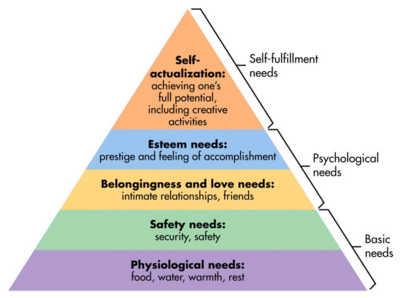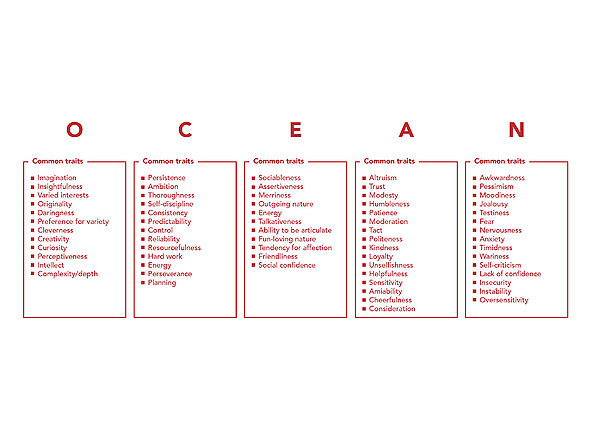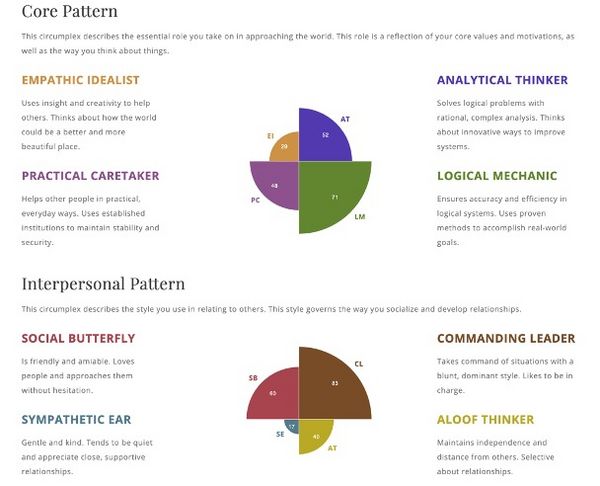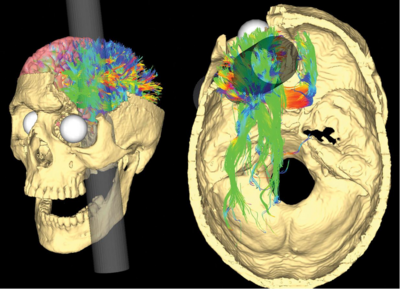The big five (OCEAN)
Timo Scheitinger
Summary / abstract
The OCEAN model, also called the five factor model or big five model, is an important component of modern personality theory in psychology. The model is composed of five main characteristics:
- Openness to experience
- Conscientiousness
- Extraversion
- Agreeableness
- Neuroticism
These characteristics vary from individual to individual and change only slightly over the course of a lifetime. Nevertheless, there are influences on the personality like genes and gender. Of course the character itself affects the environment as well and have an influence on the health, working life and relationship of the individuum. The outcome of an OCEAN model based test can be used in the program or project planning phase to delegate different tasks to the employees that fit the best.
Big idea
Definition of personality
“Personality refers to individual differences in characteristic patterns of thinking, feeling and behaving.” [1] Moreover, the definition of personality in psychology is not fixed. There are several theories that attempt to define a person's personality. The OCEAN model is widely used to define traits.
History of development
As early as ancient Greece, people discussed personality and tried to explain it with models. Hippocrates tried a model with 2 opponents:
- Moist vs dry
- Hot vs cold
According to Hippocrates, these factors make up the temperament, and thus the character, of a person. Plato then came up with the idea of dividing the personality into factors, and thus his four-factor model came into being:
- Artistic
- Sensible
- Intuitive
- Reasoning
Aristotle, in turn, studied these models and came to the conclusion that the physical body of a person has a significant influence on personality. This was not seriously considered until the case of Phineas Gage. Phineas Gage, a railway worker in the 19th century, had a serious work accident while developing a new railway line. A blast misfired and a one-metre long iron rod with a diameter of 3.2 centimetres shot through his head.
Phineas survived, but his personality changed greatly due to the damage to his brain. He took on different characteristics and became a different person, his friends reported. This made it clear that the physical size and individual areas of the brain make up the personality of an individual. [2]
Another historically important point in personality psychology was Sigmund Freud's psychoanalysis and his studies of the human mind, which laid the foundation for further insights. A far more enduring influence, however, was Carl Jung's analysis that personalities can be classified as introverted and extroverted. The American psychologist Abraham Maslow also drew on Freud's initial findings and based his hypothesis that personality is strongly dependent on the needs of the individual. Maslow created a diagram with the different levels of these needs:
- Physiological needs
- Safety needs
- Belongingness and love needs
- Esteem needs
- Self-actualization needs

Finally, an American psychologist, Lewis Goldberg, recognised that there is not only the factor extrovert and introvert. He came up with 5 factors and was thus decisive for the creation of the OCEAN model, as he was the first to recognise and combine the following factors: [3]
- Openess to experience
- Conscientiousness
- Extraversion
- Agreeableness
- Neuroticism
To this day, this is the most widely used model to determine a personality and is recognized and used internationally.
The big five [4]
Openess to experience (prefers routine, practical vs. imaginative, spontaneous)
In this area, the preference for something new is described. Aspects such as creativity, artistic interest or imaginative thinking are listed here. People with a strong sense of openness to experience are usually inquisitive and willing to think outside the box in order to question the existing and try out new approaches. They are also more sensitive to their emotions. In contrast, people with less openness can be classified as more conservative. They prefer to stick to familiar patterns and behaviour and do not break out of their routine. As far as emotional perception is concerned, these individuals feel it less strongly and do not react to it accordingly.
Conscientiousness (impulsive, disorganized vs. disciplined, careful)
The degree of determination is described here. Furthermore, self-control also plays an important role in this factor, which leads to people with a high degree of conscientiousness being organised and often taking on planning activities. Individuals with a lower level of conscientiousness tend to act more carelessly, ineffectively and spontaneously.
Extraversion (reserved, thoughtful vs. sociable, fun-loving)
This factor is particularly concerned with the social component and describes the interpersonal activity of a person. Here, a differentiation is made between the extrovert and introvert types. People with a more extroverted personality are open to conversation, seek interaction and discussion and draw their energy from talking to others. On the other hand, people who have a low level of extroversion, and are therefore more introverted, tend to avoid crowds and conversations with people they don't know. They prefer to withdraw and become individually active in their own areas and generate their energy from this.
Agreeableness (suspicious, uncooperative vs. trusting, helpful)
This factor also relates to interpersonal relationships. A person's agreeableness looks at their attitude towards others. This is mainly about the impression one leaves on one's counterpart and how the person deals with his or her environment. Thus, there are personalities with more pronounced agreeableness, which leads to them behaving in a helpful, empathetic and benevolent manner. People with low agreeableness show characteristics such as an increased competitive spirit, egocentric characteristics and mistrust.
Neuroticism (calm, confident vs. anxious, pessimistic)
Neuroticism is a factor that refers to the emotional stability of a person. A high factor ensures that the person is more receptive to negative emotions such as fear, sadness or worries. They also tend to behave insecurely in unpleasant situations such as stress. Characters who are more emotionally stable often feel more confident and rarely experience bad emotions.

Influences
Genetics & environment
Genetic predispositions have a major influence on personality factors. A twin study by Kerry L. Jang, W. John Livesley and Philip A. Vemon in 1996 showed that "Broad genetic influence on the five dimensions of Neuroticism, Extraversion, Openness, Agreeableness, and Conscientiousness was estimated at 41%, 53%, 61%, 41%, and 44%, respectively". [5] The individual environment of the person also has an influence on development, such as the circle of friends.
Gender
A study by Paul T. Costa Jr, Antonio Terracciano and Robert R. McCrae in 2001, which analyzed data from over 23,000 men and women, revealed that the influence of gender on a person's personality is very small. The difference in personalities within a gender is comparatively higher. In addition, they came to the conclusion that the personality of women in western countries differs more. The hypothesis here is the emancipation of women in many Western countries towards a stronger individual personality. In authoritarian states, a conservative everyday life is established and many women are therefore trapped in the classic role model. [6]
Impacts
Relationships
Personalities are an important part of a relationship. Agreeableness, stability and openness are essential. It is therefore very likely that if one partner has significantly fewer points in these areas than the other, there will be dissatisfaction in the partnership. The five factors therefore also influence our relationships and partnerships. [7]
Health
People with higher levels of neuroticism are much more susceptible to illnesses such as depression, mood swings, but also heart disease or asthma. In addition to neuroticism, a low level of agreeableness is also a cause of diseases and can trigger them. On the other hand, people with a high degree of conscientiousness have a kind of protective factor or a lower probability of falling ill. [8]
Work
The influences of the five factors can be divided into one factor that has the greatest influence on the way of working: conscientiousness and the other four factors that have a greater impact on specific working environments: openness to experience, extraversion, agreeableness and neuroticism. A high score in the factor conscientiousness influences the person's effectiveness and indicates high performance in working life. Neuroticism and agreeableness tend to perform better when it comes to teamwork, whereas agreeableness has a worse effect on individual performance. Here, a higher score in openess to experience is more in demand, which reinforces the individual and independent way of working. In addition, the extraversion factor is often used as a condition to look for leaders. A high score in this area is an indicator for leadership and management areas.
Tool - The big 5 in the leadership development
The OCEAN model is particularly applicable when a company is looking for a certain character trait for a position in the company. Thus, the five factors are often used in the application process of new employees or rebuilding of teams within the company. Especially for identifying a personality to take over leadership the "(...) program directors should prescreen for narcissism in the application process." [9] Project management can thus be optimized, as the analysis of individual personalities also allows individual strengths and weaknesses to emerge more clearly, and a balance of under- and overstrain of the employee can be established. A test (see figure), often in the form of a questionnaire, is completed by the person and the analysis of the character traits can then be used for further action. The NEO-PI-R test is usually used here. A more detailed subdivision of the five categories follows in here.
Application
The personality test

After answering all the questions of an OCEAN-based test, you get a detailed analysis and description of your personal behaviour patterns. In addition, the individual characteristics of the factors are explained and how they influence everyday life. With the information about what drives you and what tasks you are best suited for, this can now be used to act more effectively and successfully in the world of work and in private life.

In this way, a constellation of different personalities can be put together in the management that are suitable for a project. Since project work depends very much on the performance of the responsible team, this can strengthen the efficiency of a company and also ensure internal satisfaction in the team through the right personnel management with the help of the OCEAN analysis.
Analyzation of the environment
After a system demarcation, a more detailed look into the system and a more precise analysis follows. To understand the environment, many therefore rely on user-centred information sources and methods. For example, interviews or surveys are created and conducted. [10] Here as well, you can decide on the basis of the five-factor model who should conduct these interviews and which person should rather take over the part of documenting. As a project manager, you can now let a person who performs higher in extraversion conduct the interview, as this person naturally seeks the conversation and thus creates a more comfortable situation for the interviewee. This leads to a better output from the interview and thus to an increase in the efficiency of the analysis phase. The documenter, on the other hand, should have a high value of conscientiousness in order to record the information in a planned, organized and reliable way for easy use in the next project steps.
Ideation and new concepts
"Creativity as driving force for the search for solutions" [11] It is precisely in this phase that people who break out of their everyday work are needed. No conservative thinking, no rules and norms! In project management phases, it is also important to look beyond the horizon and become creative. As a manager, you can also draw on the results of the five-factor model and involve employees who perform particularly well in openness to experience.
Limitations
Firstly you can argue about the number 5 as a definition of character traits. Psychologists criticise that these five factors are not sufficient to explain a personality. They are only basic pillars that make up the character. Based on this, a new model, HEXACO, was developed by Kibeom Lee and Michael Ashton. In this model, another factor was added to describe the personality more completely. It deals with the honesty and modesty of a person. In addition, it can be said that a person is not automatically particularly well suited for a task in a phase of project management just because the person scores a certain number of points in a factor. Many other factors play a role, such as experience in the working world, many years of expertise and one's own motivation to drive the project forward. The result of the five-factor model test also depends heavily on the honesty of the person completing it. If the person selects the personal characteristics that he or she believes to be rather than the characteristics that describe the person in reality, the test will be distorted and deviate from reality.
Annotated bibliography
- ↑ Alan E. Kazdin PhD, Encyclopedia of psychology, 2000
- ↑ https://www.geo.de/wissen/23805-rtkl-neurowissenschaft-eine-stange-durchschlug-seinen-schaedel-warum-der-fall-von
- ↑ L. Goldberg, The structure of phenotypic personality traits, 1993
- ↑ https://positivepsychology.com/big-five-personality-theory/
- ↑ Kerry L. Jang, W. John Livesley, Philip A. Vemon, Heritability of the Big Five Personality Dimensions and Their Facets: A Twin Study, 1996
- ↑ Paul T. Costa Jr, Antonio Terracciano, and Robert R. McCrae, National Institute on Aging, National Institutes of Health, Gender Differences in Personality Traits Across Cultures: Robust and Surprising Findings, 2001
- ↑ Myers, David G., Psychology (10th ed.), Worth Publishers, 2011
- ↑ John, O. P., & Srivastava, The Big Five Trait taxonomy: History, measurement, and theoretical perspectives, 1999
- ↑ Carrie A Blair, Rachele E Palmieri, Carmen Paz-Aparicio, Do Big 5 Personality Characteristics and Narcissism Predict Engagement in Leader Development?, 2018
- ↑ Rainer Züst, Peter Troxler, No More Muddling Through Mastering Complex Projects in Engineering and Management, 2006
- ↑ Rainer Züst, Peter Troxler, No More Muddling Through Mastering Complex Projects in Engineering and Management, 2006
